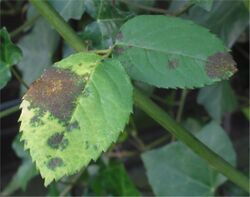Biology:Black leaf
| Black leaf | |
|---|---|
 | |
| Causal agents | potassium deficiency fungi |
| Hosts | grapevine |
| Treatment | pruning fungicides |
Black Leaf is a physiological plant disorder that affects some grape varieties such as Concord. It is essentially a potassium deficiency that causes the leaves on a vine to turn purple and eventually black as chlorophyll is lost. For wine growers this lack of chlorophyll inhibits the vine's ability to transmit sugar to the grape, leaving the resulting grapes with a low brix count that may be less than ideal for wine making.[1]
Causes
Black leaf, also known as black spot disease can be caused by different types of fungi and bacteria. Most common being Asterina, Asterinella, Diplotheca, Glomerella, Gnomonia, Schizothyrium, Placosphaeria, and Stigmea. Black leaf can affect many different plant species during wet, damp climate. It may appear as black spots on leaves, stems, and flowers.[2]
Prevention and Treatment
Treating black leaf disease can be achieved in many ways. Some include removing each affected leaf of any yellow or black color. If the infection has spread throughout a larger area, it may be best to remove the affected limb of the plant to reduce further spread. As a last resort, fungicides may be used as treatment, using organic based fungicides if possible. There are a number of remedies used to prevent the spread of black leaf disease, including mixtures of baking soda, soap, vegetable oil, and water.[3][unreliable source]
It is important to follow steps in order to prevent black leaf. Space plants at a distance when planting new crops in an area that will receive an adequate amount of sunlight. Trim each plant as needed starting from the bottom and working up to the top, making sure to dispose of any affected leaves and limbs of the plant so it cannot further spread by mixing within the soil. Be sure to keep the soil area clean of fallen leaves, as this disease thrives in cold, wet weather. When watering each plant, aim towards the base soil area to prevent adding moisture to the leaves.[3][unreliable source]
References
- ↑ R. Irvine & W. Clore The Wine Project pg 31 Sketch Publications 1997 ISBN:0-9650834-9-7
- ↑ "Black spot" (in en). https://www.britannica.com/science/black-spot.
- ↑ 3.0 3.1 https://www.wikihow.com/Deal-with-Black-Spot-Leaf-Disease Deal with Black Spot Leaf Disease
External links
- Photosynthesis and Chlorophyll Fluorescence in Blackleaf-Affected Concord Leaves - American Society for Enology and Viticulture
- Blackleaf in Grapes on www.extension.org
- Black Spot Plant Disease
- Deal with Black Spot Leaf Disease

